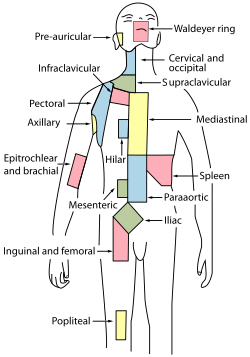Waldeyer's tonsillar ring
This article may require cleanup to meet Wikipedia's quality standards. The specific problem is: MOS & references. (December 2012) |
| Waldeyer's tonsillar ring | |
|---|---|
 Regional lymphatics. Waldeyer ring labeled at center top. | |
| Details | |
| System | Lymphatic system |
| Identifiers | |
| Latin | anulus lymphoideus pharyngis |
| Anatomical terminology | |
Waldeyer's tonsillar ring (also pharyngeal lymphoid ring or Waldeyer's lymphatic ring) is an anatomical term collectively describing the annular arrangement of lymphoid tissue in the pharynx. Waldeyer's ring circumscribes the naso- and oropharynx, with some of its tonsillar tissue located above and some below the soft palate (and to the back of the oral cavity).
Waldeyer's ring was named after the nineteenth century German anatomist Heinrich Wilhelm Gottfried von Waldeyer-Hartz.[1]
The ring consists of the (from superior to inferior):
- 1 (or two[note 1]) pharyngeal tonsils (or nasopharyngeal tonsil(s), due to the location; also known as 'adenoid(s)' when inflamed/swollen[note 2]) They are located on the roof of the nasopharynx, under the sphenoid bone.
- 2 tubal tonsil (bilaterally, where each Eustachian tube opens into the nasopharynx) (Usually develops from an accumulation of lymphoid tissue in the pharyngeal tonsil)
- 2 palatine tonsils (commonly called "the tonsils" in the vernacular, less commonly termed "faucial tonsils"; located in the oropharynx; also see tonsillitis and tonsillectomy)
- 1 (or many[note 3]) lingual tonsils (on the posterior tongue)
There also normally is a good amount of mucosa-associated lymphoid tissue (MALT) present between all these tonsils (intertonsillar) around the ring, and more of this lymphoid tissue can variably be found more or less throughout at least the naso- and oropharynx.
Some animals, but not humans, have one or two additional tonsils:
- Soft palate tonsil
- Paraepiglottic tonsil
Notes
- ^ Some authors speak of two pharyngeal tonsils/two adenoids. These authors simply look at the left and right halves of the pharyngeal tonsil as two tonsils.
- ^ which is more common in children and can obstruct respiration
- ^ Many authors also speak of lingual tonsils (in the plural), because this accumulation of lymphoid tissue consists of a number of little prominences – many smaller rounded masses. Whether to collectively call all these a single tonsil or separate tonsils is to an extent an arbitrary decision.
References
